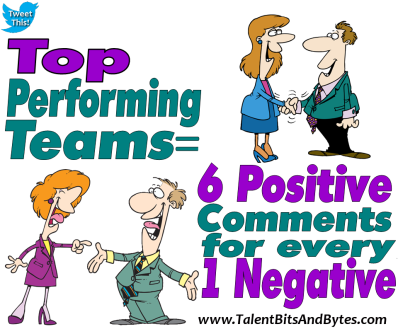Tagged: Motivation
The Secret Of Top Performing Sales Teams
 While sales success is in many ways an individual pursuit, a salesperson is usually a part of a sales team as well. Even though there might be healthy competition between members of a sales team, many of the same team dynamics that apply to other departments, apply for the sales department as well. Interesting research has been done on what factors go into separating top performing teams from bottom performing teams.
While sales success is in many ways an individual pursuit, a salesperson is usually a part of a sales team as well. Even though there might be healthy competition between members of a sales team, many of the same team dynamics that apply to other departments, apply for the sales department as well. Interesting research has been done on what factors go into separating top performing teams from bottom performing teams.
A recent article in the Harvard Business Review looked at this research¹, which showed that there was one factor that stood out as the greatest difference between top and bottom performing teams…the ratio of positive to negative comments among the team members. (Top performing teams were defined by financial performance, customer satisfaction ratings and 360 degree feedback ratings.) It’s interesting that the positive comments were not just by managers, but by the members of the team, to each other. 
Among top performing teams the researchers found that the average was 6 positive comments for every 1 negative comment. Conversely, on bottom performing teams, there were an average of 3 negative comments for every one positive comment. Ouch!
 Obviously, this is a huge difference. It’s not hard to imagine the difference in environments and how this would play out in an office. Don’t you think you would sell more in a supportive environment where you feel like your co-workers are pulling for you and noticing great work?
Obviously, this is a huge difference. It’s not hard to imagine the difference in environments and how this would play out in an office. Don’t you think you would sell more in a supportive environment where you feel like your co-workers are pulling for you and noticing great work?
(The same researchers did studies on positivity ratios needed for individuals to thrive, as well. See my earlier post, “The Number 1 Thing Your Employees Want More Of…”)
p
Study after study points to the same conclusions; positive feedback is what motivates people to improve, repeat top performance behaviors, and continue striving for success.
Positive feedback can come in the form of praise or recognition, private or public, verbal or written. EVERYONE needs it – whether the person is a seasoned pro or a rookie just starting on the job. EVERYONE NEEDS IT AND EVERYONE BENEFITS FROM IT.
For some people, positive feedback comes naturally. For others, it may be that they simply forget to do it, or are not sure how or when to do it.
Managers should encourage co-workers to do this and set the example as well. As with any feedback you give, strive to make it specific to a particular action or event, timely (as close to when it happened as possible), and of course, it should always be sincere. Smile and nod sincerely when you are listening – let them know with your non-verbal actions that you appreciate them. Listed below are some quick ways team members can give support to each other with a positive comment:
- Great job on that project!
- You should really be proud of yourself.
- Wow, tell me about how you did this!
- I’ve learned a lot from you.
- Thanks for sharing that info with me.
- You are so good at that, will you help me get better?
- Can I ask your opinion on this?
- Great catch on that mistake, you saved the day.
- Let’s try your idea!
- Thank you for listening.
- Thank you for helping.
- I keep hearing great things about you.
- You really make things happen!
- You are so creative.
- You are a great problem solver.
- I can see how much hard work you put into this.
- How do you manage so many things at once?
- You are always prepared for anything.
Now go out there and start spreading those positive comments!
p
¹ “The Role of Positivity and Connectivity in the Performance of Business Teams: A Nonlinear Dynamics Model” by Emily Heaphy & Marcial Losada American Behavioral Scientist.
See Related Articles:
10 Phrases your Salespeople Want To Hear
Steve Jobs on Hiring And Managing Talent People
20 Low-Cost or No-Cost Ways To Increase Employee Engagement
Tips For Coaching your Salespeople
